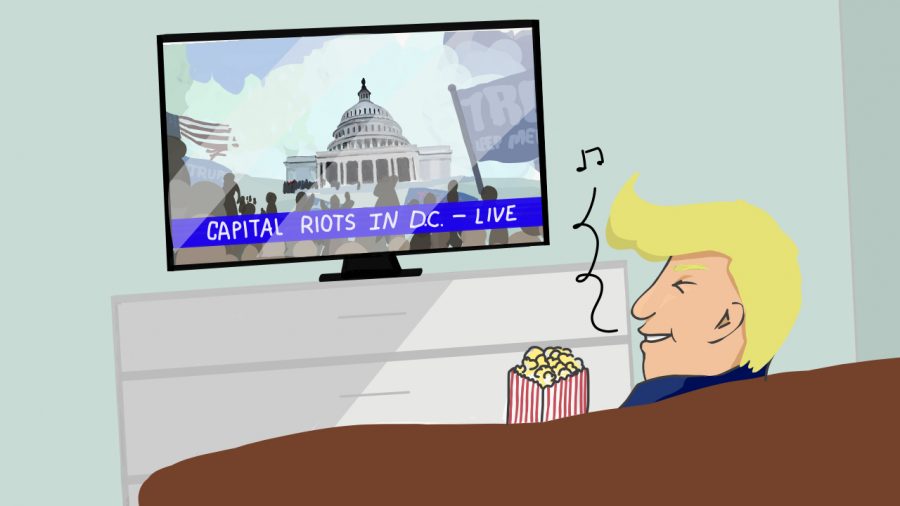What went wrong: January 6
February 23, 2021
Riots and protests have been occurring across America since the creation of the country. One of the first recorded riots in American history occurred before the Revolutionary War, in Boston. Colonists were outraged that Britain was sending over troops and continuing taxation of products, so a group of men called the Sons Of Liberty tossed thousands of pounds of tea into the harbor, signifying their unrest. These men were considered radicals and were punished for their actions by the British government by increasing the taxes that they had considered unjust.
On Jan. 6, a new group of radicals decided to protest the government, this time the American one. Many supporters of President Donald Trump were outraged at the results of the 2020 election, which Democratic candidate Joe Biden won, and believed that the election had been rigged against Trump. This opinion was formed by Trump himself when he publicly informed the world of his feelings toward his loss.
Trump constantly tweeted about the election being rigged because of the upsurge of votes that came in overnight for Joe Biden, despite the fact that this upsurge could be explained by the influx of mail-in votes that tended to lean Democratic. Trump’s consistent attempts to spread misinformation about the election eventually led to his platform on Twitter being deactivated. However, before he was deactivated, Trump began sharing word of the event for those who supported the idea that the election was unfair.
On Dec. 26, Trump tweeted, “The ‘Justice’ Department and the FBI have done nothing about the 2020 Presidential Election Voter Fraud, the biggest SCAM in our nation’s history, despite overwhelming evidence. They should be ashamed. History will remember. Never give up. See everyone in D.C. on January 6th.”
Because these radicals began their plan and riots on the basis of violence and overturning a patriotic decision, they were far less successful than they would have been if they had chosen a route of peace instead.
Jan. 6 was an important day in history, even before the riots truly began, especially in Georgia. On that day, Georgia elected Democrats Raphael Warnock and Jon Ossof to the Senate, causing the Senate to flip to a Democratic majority.
Later that day, Trump supporters met for a rally, during which Trump detailed why the election was rigged and why everyone should overturn the decision. Afterwards, the rioters began to surge the streets and marched towards the Capitol. The National Guard was eventually deployed to the Capitol, but their delay allowed the rioters to advance toward the building. Rioters quickly overcame the Capitol and began wrecking havoc.
For the first time in American history, Confederate flags were raised inside of the building, windows and doors were shattered, and property was stolen as the mob made their way towards the House chambers. The members of Congress who were inside of the chambers were forced to hide while security attempted to stop the rioters from advancing.
Trump used this rally to attempt to win back the Presidency, but instead ended up being the first President in American history to be impeached for a second time. So what failed? Why was this rally unsuccessful, despite the fact that many in the past had ended up with successful results?
One of the biggest things that the riots on Jan. 6 did wrong was be a riot. The group used so much violence and unnecessary destruction to prove a point that could have been made peacefully, with words or silence instead. Many protests in the past succeeded because of the peaceful tactics that they used when fighting for what they believed in.
For example, during Martin Luther King Jr.’s protests, he specifically instructed the use of peaceful protests instead of violence. This allowed his point to be taken more seriously and be considered in a better light.
By using violence, Trump proved that he couldn’t be trusted. The rioters wanted to be taken seriously, yet failed when they began destroying the Capitol, something viewed to be sacred and safe. Because of this, Joe Biden, not Donald Trump, was sworn in as president on Jan. 20. Trump eventually left the White House without attending Biden’s inauguration.
The riot that Trump created was not in fact the worst riot in American history, but it was an important one. It showed his cowardice and allowed many to see Trump’s true colors. No one knows how Trump will react next during Biden’s presidency, or whether or not he will attempt to be reelected in the 2024 election, but what is known is that Trump’s coup is not an event most Americans will easily forget, and will forever darken his reputation and legacy for the rest of his life.


